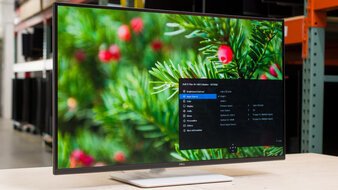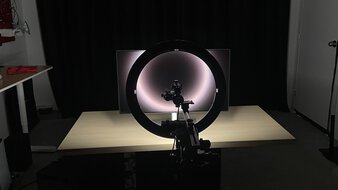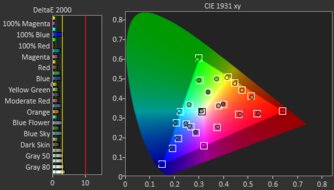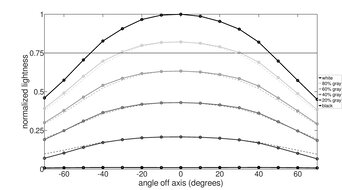USB-C ports on monitors are useful for connecting devices like laptops directly to your monitor, as they support both data and video transfer. The USB-C port needs to support either Thunderbolt or DisplayPort Alt Mode to get a video signal from a laptop, but not all USB-C monitors support these. Unlike other video connection types, most USB-C ports on monitors also deliver power to the source, so you can charge your laptop and display an image using a single cable. That said, not all monitors deliver the same amount of power, so you may need a separate charging cable if you have a power-hungry laptop. On the plus side, USB-C can also serve as an upstream port, meaning you can connect other devices to your monitor to use on your laptop, or even use it as part of a KVM switch.
When looking for a new monitor, besides the USB-C features, you should consider your budget and what you need the monitor for. Getting a high-resolution display with sharp text clarity is useful for work, and one with great color accuracy is beneficial for content creation.
We've bought and tested over 365 monitors, and below, you'll find our picks for the best USB-C monitors, including the best 4k USB-C monitor. You can also check our recommendations for the best monitors for MacBook Pro and MacBook Air, the best work monitors, and the best monitors for programming.
Quick Look






We buy and test more than 30 monitors each year, with units that we buy completely on our own, without any cherry-picked units or samples. We put a lot into each unbiased, straight-to-the-point review, and there's a whole process from purchasing to publishing, involving multiple teams and people. We do more than just use the monitor for a week; we use specialized and custom tools to measure various aspects with objective data-based results. We also consider multiple factors before making any recommendations, including the monitor's cost, its performance against the competition, and whether or not it's easy to find.
-
Best USB-C Monitor
 Office8.5USB-C Ports5USB-C Power Delivery140WKVM SwitchYesUSB-C DisplayPort Alt ModeYesThunderboltThunderbolt 4USB-C Rated Speed10Gbps (USB 3.2 Gen 2)USB-C UpstreamYesEditing7.9Brightness8.1HDR Picture6.2SDR Picture7.5Color Accuracy8.1Size27"Pixel TypeIPSMax Refresh Rate120 HzSee all our test resultsNative Resolution3840 x 2160
Office8.5USB-C Ports5USB-C Power Delivery140WKVM SwitchYesUSB-C DisplayPort Alt ModeYesThunderboltThunderbolt 4USB-C Rated Speed10Gbps (USB 3.2 Gen 2)USB-C UpstreamYesEditing7.9Brightness8.1HDR Picture6.2SDR Picture7.5Color Accuracy8.1Size27"Pixel TypeIPSMax Refresh Rate120 HzSee all our test resultsNative Resolution3840 x 2160The best USB-C monitor we've tested is the Dell U2725QE. It's a high-end 4k monitor with a large USB hub, including five USB-C ports. If you can't find it through retailers, you can also get it directly from Dell's website. Each of the USB-C ports serves a different purpose, with one supporting Thunderbolt 4 with 140W of power delivery, so this is the port to which you can connect your laptop to charge it and display an image with one cable. Another USB-C port is the Thunderbolt output, allowing you to connect another monitor directly to this one. It also has a DisplayPort output, so you can even connect an additional monitor as well. The other USB-C ports are meant to connect your devices, like a mouse and keyboard, and it has a KVM switch to change between sources and use the same devices.
Besides the features, it's a good monitor for work as it delivers sharp text and gets bright enough to fight glare, but it has a pink tint in really bright rooms. On the plus side, the 27-inch screen is big enough to comfortably view two windows side by side. However, you can consider the Dell U3225QE if you want something bigger and don't mind spending more, but it has similar performance and features otherwise.
-
Best Ultrawide USB-C Monitor
 Office8.1USB-C Ports5USB-C Power Delivery140WKVM SwitchYesUSB-C DisplayPort Alt ModeYesThunderboltThunderbolt 4USB-C Rated Speed10Gbps (USB 3.2 Gen 2)USB-C UpstreamYesEditing8.0Brightness7.7HDR Picture6.2SDR Picture7.5Color Accuracy8.9Size40"Pixel TypeIPSMax Refresh Rate120 HzSee all our test resultsNative Resolution5120 x 2160
Office8.1USB-C Ports5USB-C Power Delivery140WKVM SwitchYesUSB-C DisplayPort Alt ModeYesThunderboltThunderbolt 4USB-C Rated Speed10Gbps (USB 3.2 Gen 2)USB-C UpstreamYesEditing8.0Brightness7.7HDR Picture6.2SDR Picture7.5Color Accuracy8.9Size40"Pixel TypeIPSMax Refresh Rate120 HzSee all our test resultsNative Resolution5120 x 2160If you find that the 16:9 aspect ratio of the Dell U2725QE is too narrow for your needs, there's a class of ultrawide displays with a 21:9 aspect ratio. These provide more horizontal screen space, ideal for multitasking with many windows open. If that's what you're interested in, then look into the Dell U4025QW. It has a very similar feature set to the Dell U2725QE, as it also has a large USB hub with five USB-C ports. Like the U2725QE, it supports Thunderbolt 4, which makes full use of laptops that also support it, like MacBooks. However, one difference is that it doesn't have a DisplayPort output, so while it also has a Thunderbolt output, you can only connect one extra monitor directly to this one, instead of two.
It has a high 5k2k resolution that results in sharp text clarity, which helps if you're constantly reading documents for work. If you don't need such a big ultrawide display and you don't mind something with a lower resolution, you can also check out the Dell U3425WE. It has the same USB hub with Thunderbolt 4, and it costs less than the U4025QW, but the lower resolution means text isn't as sharp.
-
Best Mid-Range USB-C Monitor
 Office8.5USB-C Ports2USB-C Power Delivery90WKVM SwitchNoUSB-C DisplayPort Alt ModeYesThunderboltNoUSB-C Rated Speed5Gbps (USB 3.2 Gen 1)USB-C UpstreamYesEditing7.7Brightness7.3HDR Picture5.5SDR Picture6.9Color Accuracy8.9Size27"Pixel TypeIPSMax Refresh Rate60 HzSee all our test resultsNative Resolution3840 x 2160
Office8.5USB-C Ports2USB-C Power Delivery90WKVM SwitchNoUSB-C DisplayPort Alt ModeYesThunderboltNoUSB-C Rated Speed5Gbps (USB 3.2 Gen 1)USB-C UpstreamYesEditing7.7Brightness7.3HDR Picture5.5SDR Picture6.9Color Accuracy8.9Size27"Pixel TypeIPSMax Refresh Rate60 HzSee all our test resultsNative Resolution3840 x 2160If you find that the Dell U4025QW is too big for your needs, and you don't have the budget for the Dell U2725QE, then check out the ASUS ProArt Display PA279CRV. It's a mid-range option that costs less than the U2725QE, with some trade-offs. It has a smaller USB hub than the Dell, with only two USB-C ports, no Thunderbolt support, and no KVM switch either. That said, its primary USB-C still supports DisplayPort Alt Mode and 90W of power delivery, which is great if you want to connect a laptop. Although not a USB-C port, it also has a DisplayPort output to connect a second monitor directly to this one.
Besides the features, it's similar to the U2725QE as it has a 27-inch, 4k screen with sharp text clarity. The ASUS is actually the better choice for photo or video editing, as it has dedicated picture modes for various color spaces that you may work with. This includes modes for Adobe RGB, DCI-P3, and the common sRGB color space, which is very accurate without any sort of calibration.
-
Best Budget USB-C Monitor
 Office8.4USB-C Ports2USB-C Power Delivery65WKVM SwitchNoUSB-C DisplayPort Alt ModeYesThunderboltNoUSB-C Rated Speed5Gbps (USB 3.2 Gen 1)USB-C UpstreamYesEditing7.8Brightness7.0HDR Picture4.8SDR Picture7.5Color Accuracy8.8Size27"Pixel TypeIPSMax Refresh Rate120 HzSee all our test resultsNative Resolution3840 x 2160
Office8.4USB-C Ports2USB-C Power Delivery65WKVM SwitchNoUSB-C DisplayPort Alt ModeYesThunderboltNoUSB-C Rated Speed5Gbps (USB 3.2 Gen 1)USB-C UpstreamYesEditing7.8Brightness7.0HDR Picture4.8SDR Picture7.5Color Accuracy8.8Size27"Pixel TypeIPSMax Refresh Rate120 HzSee all our test resultsNative Resolution3840 x 2160If you still find the ASUS ProArt Display PA279CRV too expensive, check out a budget-friendly model like the Dell S2725QC. It has a slightly smaller USB hub than the ASUS, as it has two USB-A ports and two USB-C ports, and it doesn't have a KVM switch like the higher-end Dell U2725QE either. That said, it still supports DisplayPort Alt Mode and power delivery of up to 65W, which is still enough power to charge smaller laptops but isn't enough to charge power-hungry laptops.
It's good for productivity thanks to its sharp text clarity and 27-inch screen size. It's also fine if you want to use it in a room with some lights around, as it gets bright, but reflections are distracting in a sunny environment. Lastly, it has fantastic ergonomics, so you can easily adjust the screen to an ideal viewing position, and its wide viewing angles help if you need to share your screen with someone next to you. It's even an upgrade over the ASUS if you want something for gaming, as it has a higher refresh rate, but motion looks blurry on it, regardless.
-
Best Cheap USB-C Monitor
 Office7.1USB-C Ports1USB-C Power Delivery15WKVM SwitchNoUSB-C DisplayPort Alt ModeNoThunderboltNoUSB-C Rated Speed5Gbps (USB 3.2 Gen 1)USB-C UpstreamNoEditing6.3Brightness2.6HDR Picture2.5SDR Picture6.7Color Accuracy7.8Size24"Pixel TypeIPSMax Refresh Rate100 HzSee all our test resultsNative Resolution1920 x 1080
Office7.1USB-C Ports1USB-C Power Delivery15WKVM SwitchNoUSB-C DisplayPort Alt ModeNoThunderboltNoUSB-C Rated Speed5Gbps (USB 3.2 Gen 1)USB-C UpstreamNoEditing6.3Brightness2.6HDR Picture2.5SDR Picture6.7Color Accuracy7.8Size24"Pixel TypeIPSMax Refresh Rate100 HzSee all our test resultsNative Resolution1920 x 1080Although most entry-level, cheap monitors don't have USB-C ports, there are a few that do, like the Dell P2425H, which you can also find for a low cost directly from Dell's website if it's not available through retailers. It's a step down from the Dell S2725QC because it has a smaller screen with a lower 1080p resolution, so text isn't as sharp, and there's less screen space to work with. Its USB-C port is different from the other monitors mentioned, as it doesn't support DisplayPort Alt Mode. This means you can't display a video signal with it, and it's meant to charge small devices like your phone or connect peripherals, but it's a useful inclusion for a cheap monitor.
Besides that, it's a simple monitor without many extra features, as it doesn't support HDR at all, but that's normal for a cheap, low-cost work monitor. On the plus side, it has remarkable ergonomics, making it very easy to adjust, and its wide viewing angles are useful for sharing the screen with someone else.
Notable Mentions
-
BenQ MOBIUZ EX321UX:
The BenQ MOBIUZ EX321UX is a premium 4k monitor with better picture quality than the Dell U2725QE. This is because it uses Mini LED backlighting with deeper blacks and brighter highlights. However, only consider this over the Dell if you care about the superior picture quality, as the Dell has more USB-C ports and supports Thunderbolt 4, which the BenQ doesn't.
See our review -
LG 40WP95C-W:
The LG 40WP95C-W is an ultrawide monitor that competes with the Dell U4025QW, as it has the same 40-inch screen size and 5120x2160 resolution. It's a good choice if you find the Dell too expensive, but the LG has fewer features, as it lacks a KVM switch and has a smaller USB hub.
See our review -
ASUS ProArt Display PA278CV:
The ASUS ProArt Display PA278CV is a budget monitor with a versatile USB hub and even has a DisplayPort output. However, it has a lower resolution than the Dell S2725QC, so text isn't as sharp.
See our review -
MSI G274QPF-QD:
The MSI G274QPF-QD is a cheap 1440p monitor that's an alternative to the Dell P2425H if you want something with a bigger screen. It also supports DisplayPort Alt Mode, but it's limited to 15W of power delivery. However, it can be harder to find than the Dell.
See our review
Recent Updates
Oct 01, 2025:
We replaced the Dell S2722QC with the newer Dell S2725QC to better reflect the current market. In the Notable Mentions, we removed the hard-to-find Acer Nitro XV275K P3biipruzx and added the BenQ MOBIUZ EX321UX and the MSI G274QPF-QD.
May 26, 2025:
We replaced the Dell U2723QE with the Dell U2725QE as it has extra features. We also renamed the Dell U4025QW as the 'Best Ultrawide Monitor' and the ASUS ProArt Display PA279CRV as the 'Best Mid-Range Monitor' to reflect this change.
Feb 19, 2025:
We renamed the Dell U2723QE as the 'Best USB-C Monitor' and removed the Acer Nitro XV275K P3biipruzx because the Dell has extra USB-C features. We also added the ASUS ProArt Display PA279CRV as the 'Best Upper Mid-Range Monitor.' We removed the ASUS ProArt Display PA278CV and renamed the Dell S2722QC as the 'Best Budget Monitor' because it has a higher resolution. We moved the ASUS and the Acer to the Notable Mentions, too. Lastly, we introduced a new format to the article.
Nov 14, 2024:
Verified our picks for accuracy and consistency.
Aug 22, 2024: We replaced the ASUS ProArt Display PA279CRV with the Dell U2723QE because it has more features and is consistent with other recommendations. We also added the Dell P2425H as the 'Best Cheap Monitor.' Lastly, we removed the INNOCN 27M2V from the Notable Mentions.
All Reviews
Our recommendations are based on what we think are the best monitors with a USB-C input currently available. They are adapted to be valid for most people in each price range. The rating is based on our review, factoring in price and feedback from our visitors.
If you would prefer to make your own decision, here is the list of all of our USB-C monitor reviews. Be careful not to get too caught up in the details. Most monitors are good enough to please most people, and the things we fault monitors on are often not noticeable unless you really look for them.















